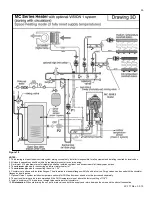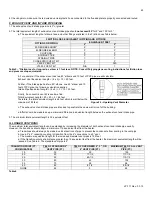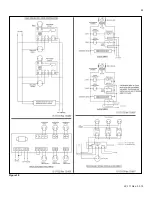
46
LP-171 Rev. 3.3.15
H. EXHAUST VENT AND INTAKE PIPE INSTALLATION
1.
The 2” exhaust vent connection is located on the top, right side of the unit, and the intake is on the top left side. Use only solid PVC
or CPVC pipe, AL29-4C Stainless Steel, or a Polypropylene vent system approved for use with Category IV appliances. FOAM CORE
PIPING IS NOT APPROVED.
All joints of positive pressure vent systems must be sealed completely to prevent leakage of flue products into living space.
2. Remove all burrs and debris from joints and fittings.
3. When using PVC or CPVC pipe, all joints must be properly cleaned, primed, and cemented. Use only cement and primer approved
for use with the pipe material. Cement must conform to ASTM D2564 for PVC and ASTM F493 for CPVC pipe.
NOTE: DO NOT
CEMENT POLYPROPYLENE PIPE.
4. Ensure the vent is located where it will not be exposed to prevailing winds.
5. In all roof venting applications, exhaust discharge must point away from the pitch of the roof.
6. If the exhaust vent is to be terminated in a walled off area (such as a roof with a parapet wall), ensure the exhaust vent terminates a
minimum of 10' from nearest wall and extends level with or above the top of the wall. This will ensure flue gas does not get trapped and
possibly recirculated into the intake air pipe, which could contaminate the combustion air.
7. To prevent water leakage, install adequate roof flashing where the pipe enters the roof.
8. Do not locate vent over public walkways, driveways, or parking lots. Condensate could drip and freeze, resulting in a slip hazard or
damage to vehicles and machinery.
9. Due to potential moisture build-up, sidewall venting may not be the preferred venting option. To save time and cost, carefully
consider venting installation and location.
10. Horizontal lengths of exhaust vent must slope back towards the heater not less than ¼" per foot to allow condensate to drain from
the vent pipe.
11. The exhaust vent must terminate where vapors cannot make accidental contact with people or pets, or damage shrubs or plants.
12. In vacant chimney applications, install and seal a rain cap over existing chimney openings.
13. All piping must be fully supported. Use pipe hangers at a minimum of 4 foot intervals to prevent sagging of the pipe where
condensate may form.
14. Do not use the heater to support any piping.
15. A screened straight coupling is provided with the heater for use as an outside exhaust termination.
16. A screened inlet air tee is provided with the heater to be used as an outside intake termination.
The following information on Table 7 lists optional intake air/exhaust vent terminations available from HTP.
DESCRIPTION
STOCK CODE
2
” PVC CONCENTRIC VENT TERMINATION KIT
KGAVT0501CVT
3” PVC CONCENTRIC VENT TERMINATION KIT
KGAVT0601CVT
2” STAINLESS STEEL VENT TERMINATION KIT
V500
3” STAINLESS STEEL VENT TERMINATION KIT
V1000
4” STAINLESS STEEL VENT TERMINATION KIT
V2000
3” POLYPRO VENT KIT
8400P-001
Table 7
I. VENTING DRAWINGS
DIRECT VENT INSTALLATION OF EXHAUST VENT AND INTAKE PIPE
If installing a direct vent option, combustion air must be drawn from the outdoors directly into the appliance intake, and exhaust must
terminate outside. There are two basic direct vent options detailed in this manual: 1. Side Wall Venting and 2. Roof Venting.
Be sure to locate the appliance such that the exhaust vent and intake piping can be routed through the building and properly
terminated. Different vent terminals can be used to simplify and eliminate multiple penetrations in the building structure (see Optional
Summary of Contents for MC120
Page 21: ...21 LP 171 Rev 3 3 15 M PIPING DETAILS Figure 5 ...
Page 53: ...53 LP 171 Rev 3 3 15 Figure 30 ...
Page 71: ...71 LP 171 Rev 3 3 15 Figure 34 ...
Page 72: ...72 LP 171 Rev 3 3 15 Figure 35 ...
Page 73: ...73 LP 171 Rev 3 3 15 Figure 36 ...
Page 76: ...76 LP 171 Rev 3 3 15 ...
Page 77: ...77 LP 171 Rev 3 3 15 ...
















































